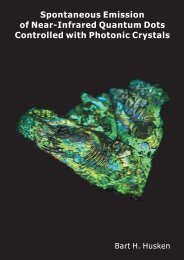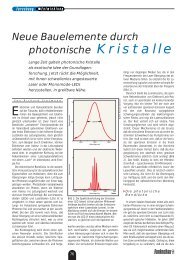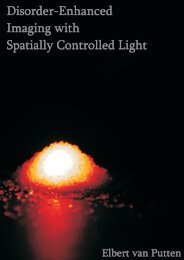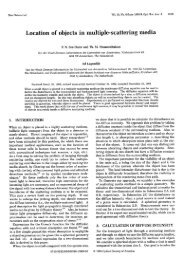Local-field effects on spontaneous emission of impurity ... - COPS
Local-field effects on spontaneous emission of impurity ... - COPS
Local-field effects on spontaneous emission of impurity ... - COPS
Create successful ePaper yourself
Turn your PDF publications into a flip-book with our unique Google optimized e-Paper software.
10 January 2000Ž .Physics Letters A 264 2000 472–477www.elsevier.nlrlocaterphysleta<str<strong>on</strong>g>Local</str<strong>on</strong>g>-<str<strong>on</strong>g>field</str<strong>on</strong>g> <str<strong>on</strong>g>effects</str<strong>on</strong>g> <strong>on</strong> sp<strong>on</strong>taneous emissi<strong>on</strong> <strong>of</strong> <strong>impurity</strong> atoms inhomogeneous dielectricsFrank J.P. Schuurmans ) , Pedro de Vries 1 , Ad LagendijkVan der Waals-Zeeman Instituut, UniÕersiteit Õan Amsterdam, Valckenierstraat 65, NL-1018 XE Amsterdam, the NetherlandsReceived 8 November 1999; accepted 29 November 1999Communicated by L.J. ShamAbstractThe local-<str<strong>on</strong>g>field</str<strong>on</strong>g> correcti<strong>on</strong>s to the sp<strong>on</strong>taneous emissi<strong>on</strong> rate <strong>of</strong> an <strong>impurity</strong> atom in an otherwise homogeneous dielectricare calculated by making use <strong>of</strong> a macroscopic approach. An extensi<strong>on</strong> <strong>of</strong> a method introduced by Onsager and Bottcher ¨ ispresented. By distinguishing between the substituti<strong>on</strong>al and interstitial character <strong>of</strong> impurities, the well-known empty-cavityand Lorentz local-<str<strong>on</strong>g>field</str<strong>on</strong>g> factors are obtained, respectively. For fluids, the substituti<strong>on</strong>al case is predicted to occur prevalently.q 2000 Elsevier Science B.V. All rights reserved.PACS: 32.80.-t; 41.20.-q; 42.25.Bs; 78.55.-mKeywords: Modificati<strong>on</strong> <strong>of</strong> sp<strong>on</strong>taneous emissi<strong>on</strong>; <str<strong>on</strong>g>Local</str<strong>on</strong>g>-<str<strong>on</strong>g>field</str<strong>on</strong>g> correcti<strong>on</strong>s; DielectricsIn 1917, Einstein dem<strong>on</strong>strated that sp<strong>on</strong>taneousemissi<strong>on</strong> must occur if matter and radiati<strong>on</strong> are toachieve thermal equilibrium wx 1 . This picture is s<strong>of</strong>undamental, that sp<strong>on</strong>taneous emissi<strong>on</strong> rates are<strong>of</strong>ten believed to be an inherent property <strong>of</strong> the atom.However, the sp<strong>on</strong>taneous emissi<strong>on</strong> rate can be modifiedby changing the envir<strong>on</strong>ment, as was noticed byPurcell wx 2 . In the early 1970s, Drexhage carried outpi<strong>on</strong>eering experiments <strong>on</strong> the modificati<strong>on</strong> <strong>of</strong> theluminescence decay rate <strong>of</strong> Europium complexes infr<strong>on</strong>t <strong>of</strong> a metallic mirror w3,4 x. Later, many theoretiw5,6xand experimental w7–11xinvestigati<strong>on</strong>s cal have) Corresp<strong>on</strong>ding author. Tel.: q31-20-5255663, fax: q31-20-5255788, e-mail: schuurma@phys.uva.nl1 Present address: KNMI, Royal Netherlands MeteorologicalInstitute, P.O. Box 201, NL-3730 AE De Bilt, the Netherlandsbeen devoted to the enhancement and inhibiti<strong>on</strong> <strong>of</strong>sp<strong>on</strong>taneous emissi<strong>on</strong> <strong>of</strong> atoms in res<strong>on</strong>ant cavities,in which case larger modificati<strong>on</strong>s are possible.Modificati<strong>on</strong>s <strong>of</strong> the sp<strong>on</strong>taneous emissi<strong>on</strong> ratecan also be induced by placing the radiator inside aspatially inhomogeneous dielectric. For example, thecase <strong>of</strong> emissi<strong>on</strong> near a dielectric interface has beenstudied both experimentally w3,4,12–14xand theoretiw15,16x. More recently, sp<strong>on</strong>taneous emissi<strong>on</strong>callyrates were predicted to alter in phot<strong>on</strong>ic crystalsw17–19x Žsee also for overviews Ref. w20 x. , materialsin which the dielectric c<strong>on</strong>stant is periodically varying<strong>on</strong> length scales <strong>of</strong> the wavelength <strong>of</strong> light. As aresult, light in a certain frequency range cannotpropagate in the crystal because <strong>of</strong> multiple Braggreflecti<strong>on</strong>s. At this so-called full phot<strong>on</strong>ic band gap,the radiative density <strong>of</strong> states Ž RDOS.is zero andfluorescence <strong>of</strong> excited atoms embedded in these0375-9601r00r$ - see fr<strong>on</strong>t matter q 2000 Elsevier Science B.V. All rights reserved.Ž .PII: S0375-9601 99 00855-5
( )F.J.P. Schuurmans et al.rPhysics Letters A 264 2000 472–477 473materials is expected to be inhibited at those frequencies,since then coupling to propagating modesis absent. At other frequencies, it has been shownthat sp<strong>on</strong>taneous emissi<strong>on</strong> can be either enhanced orreduced w17–19x Žsee also for overviews Ref. w20 x. .Note that the atoms in questi<strong>on</strong> are different from the<strong>on</strong>es c<strong>on</strong>stituting the dielectric; such atoms will bereferred to as <strong>impurity</strong> atoms or, equivalently, <strong>impurity</strong>dipoles.The sp<strong>on</strong>taneous emissi<strong>on</strong> rate G Ž ´ . <strong>of</strong> an <strong>impurity</strong>dipole inside a homogeneous medium with dielectricc<strong>on</strong>stant ´ Žat the frequency <strong>of</strong> the <strong>impurity</strong>radiati<strong>on</strong>.was predicted by Nienhuis and Alkemadew21xto follow the ' ´ dependence <strong>of</strong> the RDOS, andis thus given byŽ . 'Ž .G ´ s ´G , 10where G0is radiative decay rate <strong>of</strong> the dipole invacuum. This result was obtained by quantizing themacroscopic Maxwell’s equati<strong>on</strong>s, while in principalthe dipole couples to the microscopic vacuum fluctuati<strong>on</strong>s.The microscopic, or local, electric <str<strong>on</strong>g>field</str<strong>on</strong>g> feltby a dipole can be very different from the macroscopic<str<strong>on</strong>g>field</str<strong>on</strong>g> Žsee for example Ref. w22 x. , and hencelarge deviati<strong>on</strong>s from Eq. Ž. 1 may be expected.Determining the local <str<strong>on</strong>g>field</str<strong>on</strong>g> is an old problem inphysics, for which Lorentz has given a mean-<str<strong>on</strong>g>field</str<strong>on</strong>g>likeargument in terms <strong>of</strong> a ‘virtual’ cavity surroundw22,23x. For randoming a dipole <strong>of</strong> the dielectricfluids and cubic lattices, the resulting ratio <strong>of</strong> thelocal to the macroscopic <str<strong>on</strong>g>field</str<strong>on</strong>g> is given by the Lorentzlocal-<str<strong>on</strong>g>field</str<strong>on</strong>g> factor´q2LLors , Ž 2.3which is the same for all dipoles that c<strong>on</strong>stitute thedielectric. Indeed, in experiments w24xinvolving <strong>on</strong>lypure systems, i.e. when <strong>on</strong>ly <strong>on</strong>e kind <strong>of</strong> atom ormolecule is present, the observed local-<str<strong>on</strong>g>field</str<strong>on</strong>g> <str<strong>on</strong>g>effects</str<strong>on</strong>g>agree very well with this Lorentz descripti<strong>on</strong>. However,in the case <strong>of</strong> an <strong>impurity</strong> dipole, it is not at allclear whether Eq. Ž. 2 should apply.An alternative local-<str<strong>on</strong>g>field</str<strong>on</strong>g> correcti<strong>on</strong> that has beensuggested w25,26xis the so-called empty-cavity factorw22x3´Lemps , Ž 3.2´q1since the <strong>impurity</strong> would represent an excluded volumefor the dipoles c<strong>on</strong>stituting the dielectric. In adescripti<strong>on</strong> <strong>of</strong> G Ž ´ . <strong>of</strong> <strong>impurity</strong> dipoles inside dielectrics,<strong>on</strong>e <strong>of</strong> the factors, LLoror L emp, shouldŽ . ' 2be included, giving G ´ s ´ L G w26–33xLor 0 orŽ . ' 2G ´ s ´ L G w25,26 x. Since G Ž ´ .emp 0can be ex-pressed in terms <strong>of</strong> an expectati<strong>on</strong> value <strong>of</strong> theproduct <strong>of</strong> two electric <str<strong>on</strong>g>field</str<strong>on</strong>g> operators w26 x, thelocal-<str<strong>on</strong>g>field</str<strong>on</strong>g> factors in G Ž ´ . appear squared. The maw27–33xfavor thejority <strong>of</strong> the researchers in the <str<strong>on</strong>g>field</str<strong>on</strong>g>Lorentz factor. On the other hand, experimental rew34–36xindicate that the empty-cavity factorsultsw25xshould be employed.Recently, we have shown w37xthat for substituti<strong>on</strong>aland interstitial impurities, the empty-cavityand Lorentz-local <str<strong>on</strong>g>field</str<strong>on</strong>g> factor apply, respectively.This crucial distincti<strong>on</strong> between substituti<strong>on</strong>al andinterstitial character <strong>of</strong> the <strong>impurity</strong> was not made s<strong>of</strong>ar. Our results were obtained from a full microscopicscattering calculati<strong>on</strong> using a Green’s funcw38x.The aim <strong>of</strong> this Letter is to rederive the results <strong>of</strong>ti<strong>on</strong> formalismRef. w37xin a much simpler way. First, the local-<str<strong>on</strong>g>field</str<strong>on</strong>g>factors for both types <strong>of</strong> impurities are calculatedemploying a quasi-static macroscopic approach. Thiscalculati<strong>on</strong> is in the spirit <strong>of</strong> the method used byOnsager and Bottcher ¨ to derive the local-<str<strong>on</strong>g>field</str<strong>on</strong>g> forpure systems w23,39 x. Their method is extended hereto incorporate both substituti<strong>on</strong>al and interstitial impurities.Sec<strong>on</strong>d, the polarizability is expressed interms <strong>of</strong> a dynamic complex quantity <strong>of</strong> which theparameters are linked to <strong>on</strong>e another by invoking theoptical theorem, valid for elastic light scattering. Inthis fashi<strong>on</strong>, we obtain the appropriate local-<str<strong>on</strong>g>field</str<strong>on</strong>g>correcti<strong>on</strong>s for the sp<strong>on</strong>taneous emissi<strong>on</strong> rate <strong>of</strong> theimpurities.We first investigate the effective static polarizability<strong>of</strong> the substituti<strong>on</strong>al <strong>impurity</strong>. An <strong>impurity</strong> dipolewith polarizability a I is placed at the center <strong>of</strong> aspherical cavity with volume V in an otherwisehomogeneous medium with dielectric c<strong>on</strong>stant ´.The local-<str<strong>on</strong>g>field</str<strong>on</strong>g> correcti<strong>on</strong> pertaining to the <str<strong>on</strong>g>field</str<strong>on</strong>g> inthe cavity is then given by w23x3´LOB Ž a IrV . s . Ž 42a.I2´q1y Ž ´y1.3V
( )F.J.P. Schuurmans et al.rPhysics Letters A 264 2000 472–477 475arguments relating absorpti<strong>on</strong>, stimulated and sp<strong>on</strong>taneousemissi<strong>on</strong>. The corresp<strong>on</strong>ding dynamic polarw38xizability <strong>of</strong> the <strong>impurity</strong> in Õacuum is v 02I I 2 2 3 2v 0yv yi G0v rv 0a Ž v. sa Ž 0 . , Ž 10.Ž .Here, a Ž.I 0 is the static polarizability, v 0 the res<strong>on</strong>ancefrequency, and G0the res<strong>on</strong>ance width, whichis identical to the sp<strong>on</strong>taneous emissi<strong>on</strong> rate. The seta Ž. 0,v ,G 4I 0 0 has <strong>on</strong>ly two independent parameters,as the optical theorem relates them via w38xG0sa IŽ 0. v 0 4 r6p c03 , Ž 11.where c0is the speed <strong>of</strong> light in vacuum. Thisrelati<strong>on</strong> is c<strong>on</strong>sistent with Fermi’s Golden Rule resultfor G by taking the static polarizability a Ž.0 I 0s2< D< 2 r´ 0"v0 in terms <strong>of</strong> the dipole matrix elementD <strong>of</strong> two atomic levels. These relati<strong>on</strong>s holdfor a dipole in vacuum. When c<strong>on</strong>sidering a dipole ina background medium with dielectric c<strong>on</strong>stant ´ andneglecting local-<str<strong>on</strong>g>field</str<strong>on</strong>g> or cavity <str<strong>on</strong>g>effects</str<strong>on</strong>g>, Eq. Ž 11.ismodified to G Ž ´ . s ' ´G, 0 with G0determined bythe polarizability and the res<strong>on</strong>ance frequency as inEq. Ž 11 .. This is in agreement with the Nienhuis andAlkemade result, see Eq. Ž. 1 .Implementing the dynamic polarizability a Ž v.Ifor the static <strong>on</strong>e a in Eq. Ž.I 6 readily gives theeffective dynamic polarizability a Ž v.sub,I <strong>of</strong> a substi-tuti<strong>on</strong>al <strong>impurity</strong>asub,IŽ v.y12aIŽ v .Ž ´y1.L2empsaIŽ v.Lemp1y .9´VŽ 12.The polarizability <strong>of</strong> this ‘dressed’ <strong>impurity</strong> nearres<strong>on</strong>ance has a Lorentzian structure analogous toEq. Ž 10 .:asub,I Ž v. sasub ,I Ž 0.v 02 Ž ´ .=,2 2 3 2v 0Ž ´ . yv yiŽ G Ž ´ . v rv 0Ž ´ ..Ž 13.with parameters given by2v 0Ž ´ . 2a IŽ 0 .Ž ´y1.Lemps 1y2v 0 9´V, Ž 14.v 02 2asub,I Ž 0. sLemp a Ž 0 ., 2 Iv Ž ´ .Ž 15.2G ´ v 0 ´' 2emp 2G0 v 00Ž . Ž .s ´ L . Ž 16.Here, the sp<strong>on</strong>taneous emissi<strong>on</strong> rate G Ž ´ . <strong>of</strong> thesubstituti<strong>on</strong>al <strong>impurity</strong> follows from the polarizabilitya Ž. 0 and the res<strong>on</strong>ance frequency v Ž ´ .sub,I 0 byuse <strong>of</strong> the optical theorem, see Eq. Ž 11 .. It should benoted that a direct calculati<strong>on</strong> <strong>of</strong> G Ž ´ . from Eq. Ž 13.is not feasible, as the macroscopic derivati<strong>on</strong> presentedhere is in essence quasi-static, and hence <strong>on</strong>lyaccounts for a real polarizability. This drawback isnot encountered in the full, but more complicatedcalculati<strong>on</strong> <strong>of</strong> Ref. w37 x. In vacuum, ´s1, the originalresults are regained, that is v Ž. 1 sv , a Ž.0 0 sub,I 0sa Ž. 0 , and G Ž.I 1 sG 0. The res<strong>on</strong>ance frequency isred-shifted and the line width behaves in accordancewith the empty-cavity descripti<strong>on</strong>, identical to ourearlier results w37 x.The dynamical properties <strong>of</strong> an interstitial <strong>impurity</strong>are obtained in a similar fashi<strong>on</strong> as for thesubstituti<strong>on</strong>al <strong>on</strong>e. As a result, the polarizability <strong>of</strong>the ‘dressed’ interstitial <strong>impurity</strong> also has aLorentzian line shape given by Eq. Ž 13 .. The parametersfor the interstitial case are2v 0Ž ´ . 2a IŽ 0 .Ž ´y1.LLors 1y2v 0 9´V, Ž 17.v 02 2aint ,I Ž 0. sLLor a Ž 0 ., 2 Iv Ž ´ .Ž 18.2G ´ v 0 ´' 2Lor 2G0 v 00Ž . Ž .s ´ L . Ž 19.Again the res<strong>on</strong>ance frequency is red-shifted, althoughwith a different functi<strong>on</strong>al dependence <strong>on</strong> ´.The Lorentz local-<str<strong>on</strong>g>field</str<strong>on</strong>g> factor is found to determinethe modificati<strong>on</strong> <strong>of</strong> the sp<strong>on</strong>taneous emissi<strong>on</strong> rate, inagreement with Ref. w37 x.
476( )F.J.P. Schuurmans et al.rPhysics Letters A 264 2000 472–477The obtained results for both the substituti<strong>on</strong>aland interstitial <strong>impurity</strong> still depend <strong>on</strong> the volume<strong>of</strong> the cavity V. For the case <strong>of</strong> the interstitials they1volume is fixed: Vsr Ž Onsager’s assumpti<strong>on</strong> ..For substituti<strong>on</strong>als, V is generally taken to be thereal volume <strong>of</strong> the <strong>impurity</strong> atom or molecule. Forsmall <strong>impurity</strong> volumes, V-r y1 , <strong>on</strong>ly <strong>on</strong>e dipole<strong>of</strong> the dielectric is expelled from the cavity. If the<strong>impurity</strong> is large, V4r y1 , many dipoles <strong>of</strong> thedielectric are removed, and the <strong>impurity</strong> is a truemacroscopic cavity.The res<strong>on</strong>ance frequency <strong>of</strong> the <strong>impurity</strong> slightlyshifts to the red, see Fig. 1. This shift is a directc<strong>on</strong>sequence <strong>of</strong> the reacti<strong>on</strong> <str<strong>on</strong>g>field</str<strong>on</strong>g> produced by thepolarizati<strong>on</strong> in the medium that is induced by the<strong>impurity</strong> dipole. For small <strong>impurity</strong> polarizati<strong>on</strong> densitiesŽa Ž 0. rV









